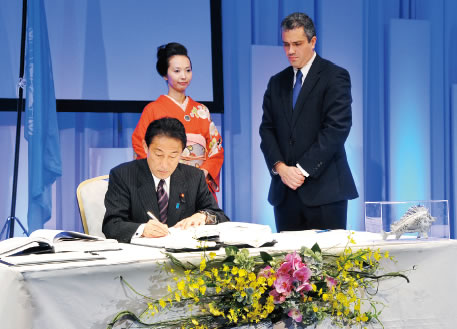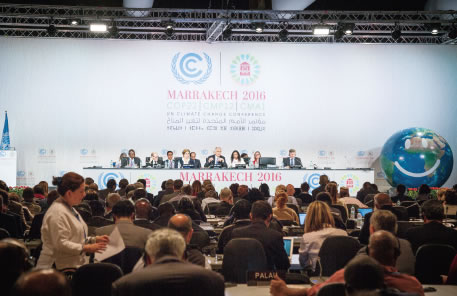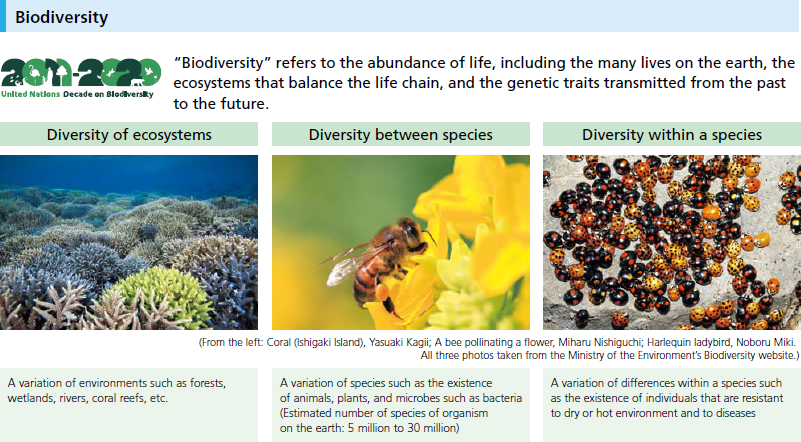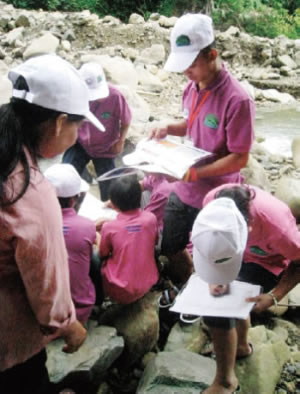3. Building a Sustainable and Resilient International Community through Efforts to Address Global Challenges
As globalization advances, transboundary challenges facing humanity such as environmental issues, climate change, water-related issues, major natural disasters, infectious diseases, food issues, and energy issues significantly affect not only developing countries but also the international community as a whole. These global challenges cannot be dealt with by a single country, and require united efforts by the international community. 2015 was an important milestone year for the international community’s response to various global challenges for the holding of major international conferences, including the UN Summit (September, New York), which adopted the 2030 Agenda that succeeds the MDGs, and COP 21 (November-December, Paris), which adopted the Paris Agreement, a new international framework on climate change for 2020 and beyond. In 2016, as “the first year of implementation” in which we move to implement these efforts, specific activities were commenced in all fields. For example, in the health field at the fora of the G7 Ise-Shima Summit and TICAD VI, a series of discussions were held together with the international community regarding the importance of the achievement of UHC which is useful for responding to public health emergencies and also for prevention of and preparedness for health crises from times of peace.
Japan has contributed to building a sustainable and resilient international community through these proactive efforts to address global challenges and through the Third UN World Conference on Disaster Risk Reduction (March 2015, Sendai) at which the Sendai Framework for Disaster Risk Reduction 2015-2030, the international goal for disaster risk reduction by 2030, was adopted.
(1) Environment and Climate Change Actions
Environment and climate change issues have been repeatedly taken up as one of the main topics at the G7/8 and G20 Summits, and awareness of the importance of tackling these issues has grown internationally in recent years. For example, these topics were also brought up in the 2030 Agenda adopted at the United Nations General Assembly in September 2015. To date, Japan has been vigorously working on addressing these issues, and will continue to actively participate in discussions in the international community.
<Japan’s Efforts>
| Environmental Pollution Control Measures

Foreign Minister Fumio Kishida attended the Conference of Plenipotentiaries on the Minamata Convention on Mercury held in Kumamoto and signed the Convention in October 2013.
Japan has accumulated an abundance of knowledge, experience and technology related to environmental pollution control measures, and has been utilizing them to solve pollution and other problems in developing countries.
The Minamata Convention on Mercury adopted at the Conference of Plenipotentiaries held in Kumamoto in October 2013 has the objective of protecting the health of people and the environment from mercury. Having learned the lessons from Minamata disease, Japan actively participated in the formulation of the convention, and concluded it in February 2016. At the Conference of Plenipotentiaries Japan announced the implementation of and has actually been implementing $2 billion of ODA support to counter environmental contamination in developing countries, focusing on the three areas of air pollution, water pollution and waste management, and to contribute specifically to a capacity building program dedicated to the prevention of mercury pollution over the three years from 2014.
| Climate Change

The 22nd Session of the Conference of the Parties to the United Nations Framework Convention on Climate Change (COP 22) held in Marrakech, Morocco in November 2016 (Photo: (C) UNFCCC)
Climate change is an urgent issue that requires a crossborder approach. According to the Synthesis Report of the latest Fifth Assessment Report (Note 35) published by the Intergovernmental Panel on Climate Change (IPCC) in November 2014, the global average air temperature rose by 0.85°C from 1880 to 2012. Against this backdrop, the international community, including both developed and developing countries, must strengthen its united efforts to address climate change. Japan actively engages in the negotiations on international efforts to tackle climate change, which are conducted under the UN Framework Convention on Climate Change.
Due to the fact that the Kyoto Protocol adopted in 1997 imposed the obligations of reducing greenhouse gas (GHG) emissions only on developed countries, negotiations were held over many years in order to build a new framework under which all countries would tackle GHG emission reductions. As a result, at the 21st Session of the Conference of the Parties to the UN Framework Convention on Climate Change (COP21) (from November 30 to December 13, 2015 in Paris), the Paris Agreement, a framework in which all countries participate, was adopted as a new framework starting from 2020. To boost the adoption of this important agreement, Prime Minister Abe announced Actions for Cool Earth 2.0 (ACE2.0) comprised of the two pillars of support to developing countries and innovation at COP21. In particular, he expressed that Japan would provide, in 2020, approximately ¥1.3 trillion of public and private climate finance, 1.3 times higher than the current level, to developing countries in order to facilitate the adoption of the Paris Agreement.
The Paris Agreement came into effect on November 4, 2016 with the ratification of major emitters including the United States, China, EU, India, and Brazil. (Japan also concluded the agreement on November 8). Subsequently, important progress towards steady implementation of the agreement has been made. For example, the decision to adopt the relevant guidelines for implementation of the agreement by 2018 was made at the 22nd Session of the Conference of the Parties to the UN Framework Convention on Climate Change (COP22) (from November 7 to 18 in Marrakech, Morocco) and the 1st Session of the Conference of the Parties serving as the Meeting of the Parties to the Paris Agreement (CMA1) (November 15 to 18) were held, etc. In particular, at the COP22, the accomplishment of the international community on the effort to support developing countries in the area of climate change was revealed when some developing countries welcomed the “Roadmap to US$100 Billion” announced by the developed countries in advance. Furthermore, in conjunction with this meeting, Minister of the Environment, Koichi Yamamoto, announced Japan’s Assistance Initiatives to address Climate Change Responding to Needs of the Developing Countries which summarizes and clearly delivers Japan’s major support for developing countries in the climate change field, including the Asia-Pacific Adaptation Information Platform.
Moreover, in order to actively contribute to addressing the urgent challenges of climate change, Japan is steadily working to achieve its Nationally Determined Contribution (NDC)* to reduce GHG emissions at a level of 26% compared to FY2013 (down by 25.4% compared to FY2005) to FY2030, and is proactively engaged in promoting the development of innovative technologies in the fields of environment and energy, and supporting climate change actions in developing countries.
As part of this initiative, Japan has been promoting the use of the Joint Crediting Mechanism (JCM)* which facilitated the global diffusion of advanced low-carbon technologies. The JCM is a mechanism to appropriately evaluate the contributions of Japan to GHG emission reductions or removals in a quantitative manner and use them to achieve Japan’s emission reduction target through the diffusion of low-carbon technologies and implementation of climate change actions in developing countries. Beginning with the signing of the first bilateral document pertaining to JCM implementation with Mongolia in January 2013, Japan has established the JCM with 16 countries, including Mongolia, Bangladesh, Ethiopia, Kenya, Maldives, Viet Nam, Laos, Indonesia, Costa Rica, Palau, Cambodia, Mexico, Saudi Arabia, Chile, Myanmar and Thailand, as of the end of 2015 (in addition to these 16 countries, Japan and the Philippines have signed a memorandum aimed at signing a bilateral document). JCM credits were issued for the first time in May 2016 for energy-efficient refrigeration equipment installation in Indonesia and following this, in September JCM credits were also issued from projects to introduce high-efficiency boilers in Mongolia in September 2016. These efforts underscore the clear achievements of the JCM.
In addition to these efforts, Japan decided to contribute $1.5 billion (approximately ¥154 billion) to the Green Climate Fund (GCF)* in May 2015, to support developing countries’ efforts to tackle climate change. Japan’s contribution enabled GCF to start financing developing
| Biodiversity

Children hold Linckia laevigate, the starfish indigenous to the tropical regions on the coast of Malu’u, Malaita Province in Solomon. (Photo: Yusuke Nishiyama)
Expansion in the types, scope and scale of human activities in recent years has given rise to serious concerns about further degradation of habitats and the destruction of the ecosystem. The Convention on Biological Diversity (CBD) was adopted in 1992 based on the realization that issues related to living organisms are borderless, and that the entire world should be focusing on biodiversity issues. The objectives of the CBD are: (i) conservation of biological diversity; (ii) sustainable use of the components of biological diversity;* and (iii) fair and equitable sharing of the benefits arising from the utilization of genetic resources. Developed countries are providing economic and technical assistance to developing countries in order to facilitate the conservation and sustainable use of biological diversity worldwide.
Japan, which places importance on biodiversity, hosted the 10th Meeting of the Conference of the Parties to the Convention on Biological Diversity (COP 10) in Nagoya City, Aichi Prefecture in October 2010. In December 2016, the 13th Meeting of the Conference of the Parties to the Convention on Biological Diversity (COP 13) was held in Cancún, Mexico. With the major theme of “actions to integrate conservation and sustainable use of biodiversity in the forestry, fisheries, agriculture, and tourism sectors,” discussions were held about a variety of issues, in particular the mainstreaming of biodiversity. In addition, the 2017 to 2020 Short-Term Action Plan for strengthening the capacities of developing countries was adopted. At the Ministerial Meeting held in advance of COP 13, nine countries and organizations including Japan announced an initiative aimed at achievement of the Aichi biodiversity targets* for 2020 and Japan announced support for efforts on a global scale through capacity development by the Japan Biodiversity Fund.

| Promotion of Education for Sustainable Development (ESD)
Activities related to Education for Sustainable Development (ESD) are held worldwide under the Global Action Programme on ESD (GAP), adopted as a successor program to the UN Decade of Education for Sustainable Development (DESD), since the UNESCO World Conference on the Education for Sustainable Development (ESD)* held in Okayama City, Okayama Prefecture and in Nagoya City, Aichi Prefecture in November 2014. Japan supports the implementation of GAP through financial contribution to a trust fund at UNESCO, and is actively promoting ESD by establishing the UNESCO-Japan Prize on ESD.
- * Nationally Determined Contribution (NDC)
- This refers to the GHG emission reduction target prepared by each country itself based on the Paris Agreement Article 4, Paragraph 2. The Paris Agreement stipulates that it should be communicated every five years and domestic mitigation measures should be taken by each country to achieve its objectives.
- * Joint Crediting Mechanism (JCM)
- JCM refers to a mechanism to appropriately evaluate contributions from Japan to GHG emission reductions or removals in a quantitative manner and use them to achieve Japan’s emission reduction target through the diffusion of low-carbon technologies, products, systems, services, and infrastructure as well as implementation of mitigation actions in developing countries.
- * Green Climate Fund (GCF)
- GCF is a fund established by the decision of the Cancun Agreements adopted at COP 16 in 2010, in order to support low-emission (mitigation) and climate-resilient (adaptation) investments in developing countries.
- * Sustainable Use of the Components of Biodiversity
- Humans subsist by making use of the components of biodiversity in various forms, including food production by the agricultural, forestry, and fishery industries and the collection of industrial raw materials. However, biological diversity is being lost across the globe due to climate change, environmental degradation caused by development among other factors. In order to secure the utilization of biological resources towards the future, it is important to maintain the Earth’s biodiversity at the levels of the ecosystem, species, and genes, and ensure the conservation of biodiversity and sustainable use of its components.
- * Aichi Biodiversity Targets (The Strategic Plan for Biodiversity 2011–2020)
- These are the targets set in the strategic plan for biodiversity 2011- 2020 of the Convention on Biological Diversity adopted at COP10 in 2010. The strategic plan sets out a goal of “Living in harmony with nature” by 2050, as a mission to halt the loss of biodiversity by 2020, in addition to 20 individual targets called the “Aichi Biodiversity Targets.”
- * Education for Sustainable Development (ESD)
- ESD refers to education to foster supporters of a sustainable society. In this context, “sustainable development” means the development that “meets the needs of the present generation while also meeting the needs of the future generation.” To build a society that realizes this, it is necessary to recognize a variety of challenges in contemporary society such as the environment, poverty, human rights, peace, and development as one’s own problem, and work to find solutions for them. For that purpose, creating new values and actions is important.
- Note 35: The IPCC Fifth Assessment Report consists of the three assessment reports of Working Groups I, II, and III and the Synthesis Report, a report that integrates the findings of the three working group reports, published between 2013 and 2014.
•Malaysia
Project on Sustainable Development for Biodiversity and Ecosystems Conservation in Sabah
Technical cooperation project (July 2013 – )

Participants practice water quality survey techniques at the leader training of the river environmental education. (Photo: JICA)
Sabah State in Malaysia has diverse ecosystems and biota, from mangrove forests in which proboscis monkeys live and lowland tropical forests in which Asian elephants live, to Mount Kinabalu, the highest peak in Southeast Asia. However, since the 1970s large-scale developments such as oil palm plantations have progressed, and the forest area has declined to two-thirds of that of before. Environmental problems such as soil degradation and water pollution also have become obvious, which is a threat to the livelihoods of the local residents who are highly dependent on natural resources.
Under such conditions, responding to a request of the Government of Malaysia, Japan has implemented the Technical Cooperation Programme for Bornean Biodiversity and Ecosystems Conservation in Sabah, Malaysia*1 over ten years since 2002. Phase 1 of this program carried out human resources development in the areas of research, park management, and habitat management. Phase 2 offered support for the opening of the Sabah Biodiversity Centre, registration as a Ramsar Convention wetland, and the building of a policy framework including the establishment of the Sabah biodiversity strategy. As a result of this cooperation, a comprehensive strategy regarding biodiversity was established in Sabah State ahead of other states and an implementation structure for protected zone management was developed.
However, Malaysia believed that it was necessary to receive further technical cooperation in order to implement the biodiversity strategy, conduct integrated management including the buffer areas surrounding the protected zone, and disseminate the outcomes to date to the other states and outside the country. Thus it called on Japan to implement a successor technical cooperation project, the Project on Sustainable Development for Biodiversity and Ecosystems Conservation in Sabah (SDBEC).
In this project which commenced in July 2013, one of the activities was to support the improvement of the capabilities of the related people, including the residents living in the vicinity of the protected region, in order to realize a society in harmony with nature. For example, initiatives aiming at improving the livelihoods of the residents through beekeeping, the cultivation and processing of mulberries, and making organic compost were carried out at two pilot sites. Furthermore, in the villages located beside rivers environmental education regarding the conservation of rivers was also implemented.
It is expected that these initiatives will spread from Sabah State to other regions and also to other states and even outside the country as a model for a society in harmony with nature that contributes to the conservation of biodiversity and ecosystems, and will contribute to the promotion of sustainable development. (As of August 2016)
- *1 Phase 1 was implemented from February 2002 to January 2007 and Phase 2 was implemented from October 2007 to September 2012.
•Viet Nam
Support Program to Respond to Climate Change
ODA loan (FY2010 – FY2016)

Viet Nam flood damage (Photo: JICA)
Energy consumption in Viet Nam increased by approximately 2.8 times between 1995 and 2011 due to rapid economic growth, and the rate of increase in emissions of greenhouse gases (GHG) in Viet Nam (1995-2012) was the second highest among the major ASEAN countries (Indonesia, Malaysia, the Philippines, Singapore, Thailand, and Viet Nam). Furthermore, Viet Nam has a long coast line of approximately 3,400 kilometers and an enormous delta area, so it is one of the countries that are most vulnerable to the effects of climate change. The increasing frequency and seriousness of the disasters resulting from climate change in future are considered to be serious risk factors for the sustainable development of Viet Nam.
In response to this situation, the Government of Viet Nam announced the National Target Program to Respond to Climate Change in 2008 and spelled out measures to combat climate change in the areas under the jurisdiction of each government ministry and agency, with 2020 as the target year for achieving them. Furthermore, in 2011 it announced the National Strategy on Climate Change, a policy regarding mitigation of climate change through removal and reduction of emissions of GHGs and strengthening adaptation capabilities with respect to the impact of climate change. In 2012 the Green Growth Strategy was announced which has the objective of simultaneous realization of sustainable development and social and economic development in the medium- to long-term.
In order to boost these initiatives by the Government of Viet Nam for measures to combat climate change, Japan has started support for these measures through financial support and policy dialogue since 2009. Specifically, Viet Nam carried out policy and system development regarding forest management and energy saving. After evaluating the status of achievement of that development through policy dialogue, Japan provided financial support through ODA loans. Through the support to date, Japan has played an important role in the development of national laws and systems pertaining to measures to combat climate change in Viet Nam, namely the establishment of the Law on Water Resources and formation of a framework for the introduction of renewable energy.
•Nepal
Improving Living Environment of Communities through Prevention and Pollution Control of the Bagmati River by the Local Community People in Kathmandu
Grant assistance for Japanese NGO projects (February 2014 – )

A survey for the current conditions of the Bagmati River by conducting creatures observations from its upper to lower stream and performing water quality tests (Photo: Mura no Mirai)
The Bagmati River flowing through the Kathmandu Valley is a water source supporting the lives of the people living in Kathmandu.
While the population has grown rapidly in Kathmandu over the last 20 years and many houses have been constructed, development of garbage collection and sewage treatment systems cannot keep pace with such environmental changes. Uncollected garbage has been discarded on the banks of the river and untreated wastewater has been released into the river. In this way, the contamination of the Bagmati River has become serious and especially in the lower stream it has deteriorated to the point where no creatures can live, so the river has been given the name of “dead river.” The people of Kathmandu are now threatened with a worsening living environment.
For that reason, since February 2014 Japan had provided grant assistance for Japanese NGO projects to build Decentralized Wastewater Treatment Systems (DEWATS) in every village in the midstream areas of the Bagmati River where the contamination was anticipated to worsen. The residents by themselves can manage and keep maintenance of the systems. These systems are intended to prevent the worsening of the living environment caused by the contamination of the river, but systems alone cannot work without proper management and maintenance by the residents.
Accordingly, the project has been designed not only to build the systems, but also to provide the residents who use the systems with such training sessions in order for them to understand how the river will be contaminated, how DEWATS works and how much it costs to build the systems. These sessions can allow them to think about implementing specific and feasible plans about who does what, when and where and how much of the cost to maintain the systems they bear.
The assistance activity at two places (Deshe village and Basnet village) in the midstream area of the Bagmati River has been completed so far. In Deshe village, a DEWATS was built that can treat household wastewater for 177 households, and in Basnet village, a DEWATS for 66 households that can also treat wastewater from a neighboring national park. In these villages, the management and maintenance and use of the systems by the residents have already begun. The residents have started not only management and maintenance of the systems but also voluntary activities such as the installation of garbage boxes in the villages and cleaning once a week.
Furthermore, 18 residents have been trained as instructors in order to spread environmental conservation efforts to other regions. Preparations have been made to ensure that the residents will be able to disseminate such activities by themselves after the project ends. (As of August 2016)
